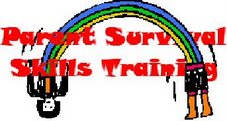I was at an training for a day and a half where the Adolescent Brain under the effects of drug abuse was examined. The trainer, Michael Nerney, really knew this subject backwards and forwards. He was also really funny and I think the humor got some good brain chemistry going for the training participants, making learning more likely. It reminded me of the funny things that come up at PSST. We know the subject isn't funny, but gee, sometimes you just have to have to have a bit of a laugh.
I would like to share a couple of things we covered. One, Adolescent Brains are under such rapid growth that indeed they are in many ways not like adult brains. Once we understand this, we can understand some of these mysterious behaviors such as risk-taking. Teen brains are "wired" for risk taking; therefore, if they don't have opportunities for legitimate risk-taking opportunities, they are more drawn to illegal risk taking. Also, their developing brains are not as able to assess the danger associated with the risks. That will come later, once they have an adult brain. Therefore, it is important that adults help teenagers enter into legitimate risk taking, such as sports or other competitions.
Two, we are right to try to buy as much clean-time for our teenagers via our various PSST strategies because the earlier and the deeper that our teens travel into drug abuse the more likely that they will have substance abuse and other problems for the rest of their lives. Yes, the good news is that brains can often heal after damage- but the bad news is that it takes quite a while for brains to heal and the damage can be very serious. Further, teens remain at a high risk for relapse while their brains are healing and that healing could take years. For example, "The hippocampus encodes new information into memory. Adolescents with a history of alcohol use disorder have a smaller hippocampus volume (on average, by about 10 percent.)"
This FRONTLINE video covers some of what we learned although it is not a video that was featured at our training. Note that it has Chapter links and you are free to skip ahead. 
As I mentioned, the training in which I participated was excellent.
"The Adolescent Brain and Chemical Dependency
Recent research indicates that the time frame from 14 year to 24 years of age is
exceptionally risky. New insights into brain development, gained through the use
of new technology, demonstrate specific conditions that exist in the brain only
during adolescence. Linking this research to the stages of adolescent development
has generated better understanding of the way in which adolescents perceive the
world, themselves, and their behaviors.
The Center is pleased to announce that Michael Nerney, Executive Director of
Michael Nerney and Associates, will return to facilitate this workshop that he
last presented at a Center sponsored event in the spring of 2005 where he earned
a 6.4 evaluation score on our 7-point scale. Michael Nerney is a consultant in
Substance Abuse Prevention and Education, with over thirty years’ experience in
the field. He is an internationally known lecturer, and has served as consultant to
a number of federal and state agencies, including the federal Office of Substance
Abuse Prevention and the Bureau of Justice Assistance; the New York State
Education Department, Department of Social Services, Division for Youth,
Department of Correctional Services, Division of Probation and Correctional
Alternatives, Division of Parole, Division of Criminal Justice Services, Capital
Defender’s Office and Governor’s Office of Employee Relations. Mr. Nerney has
provided consultation on drug courts and other areas of technical assistance to
correctional systems across the country, including the states of California, Texas,
Alabama, Delaware, New Mexico, Connecticut, North Carolina, and Oregon. He
has been a consultant for two of the major television networks and has appeared
on the ABC program 20/20. He is the father of four children."
Quote of the Week
"If I cannot do great things, I can do small things in a great way" ~ Martin Luther King, Jr.
The Adolescent Brain
Posted by:Lloyd Woodward--Friday, April 16, 2010
Posted by:Lloyd Woodward
--
Friday, April 16, 2010
![]()
Subscribe to:
Post Comments (Atom)
















No comments:
Post a Comment